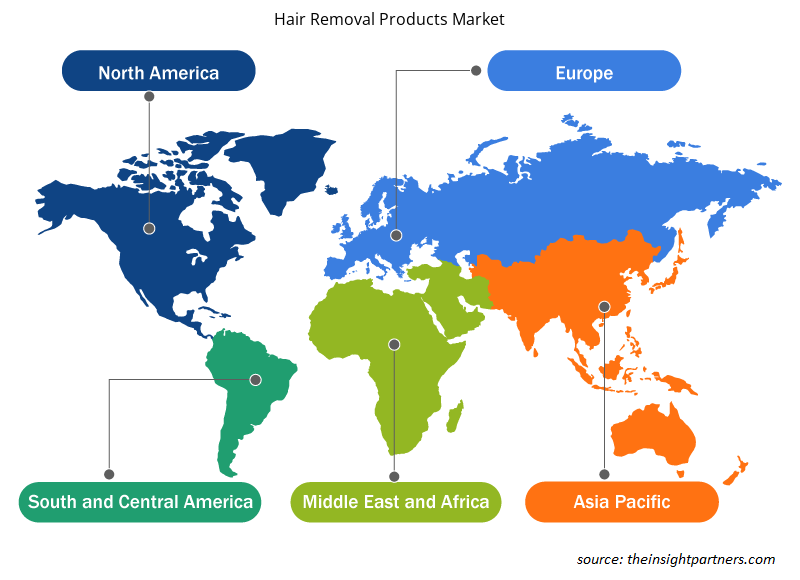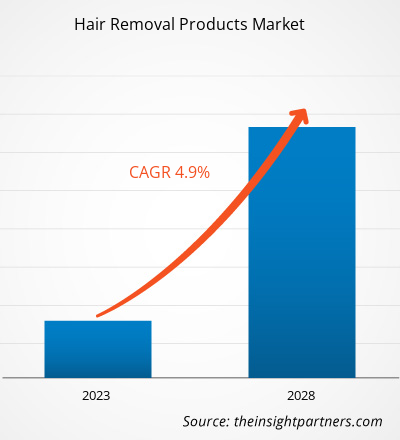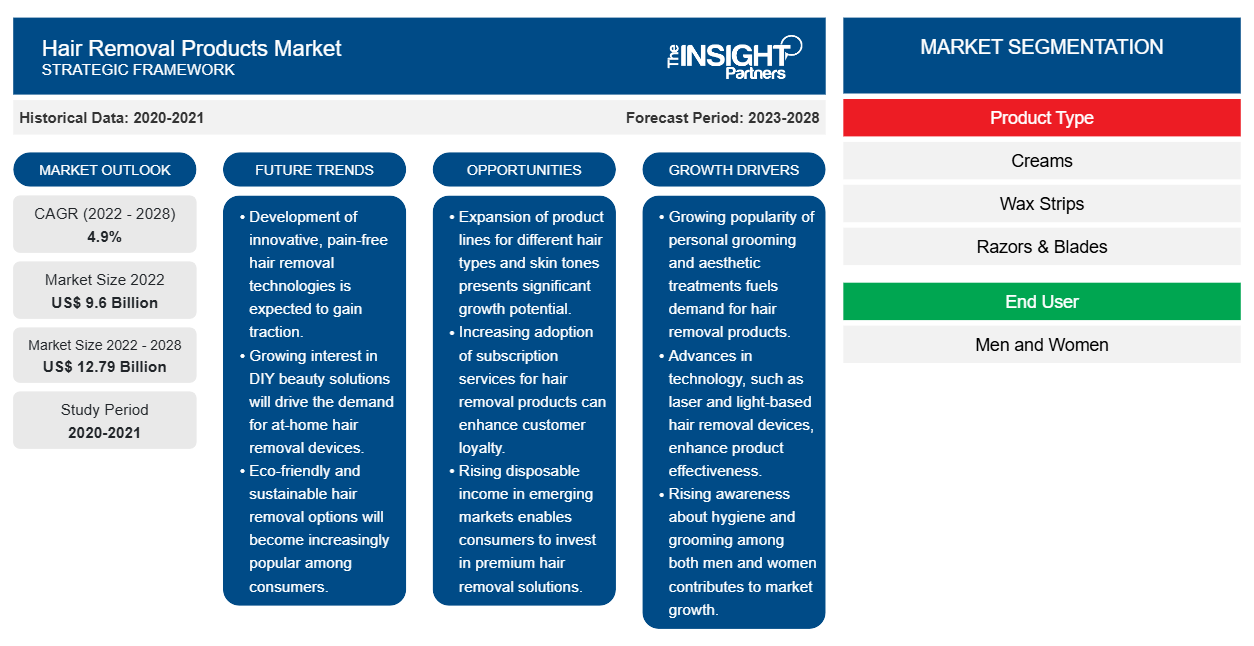[Rapporto di ricerca] Si prevede che il mercato dei prodotti per la depilazione crescerà da 9.596,39 milioni di dollari nel 2022 a 12.786,19 milioni di dollari entro il 2028; si stima che registrerà un CAGR del 4,9% dal 2022 al 2028.
Prodotti per la depilazione come creme, strisce di cera, rasoi e lamette, epilatori, cera, spray, gel e altri sono usati per rimuovere i peli dal corpo umano. Il mercato globale è segmentato in base al tipo di prodotto, all'utente finale e al canale di distribuzione. La popolazione in crescita e l'elevata spesa dei consumatori per prodotti per la cura della persona, soprattutto negli uomini, spingono la domanda di prodotti per la depilazione in diverse regioni.
La quota di mercato globale dei prodotti per la depilazione per l'Asia Pacifico è stata la più grande nel 2022. In base al paese, il mercato dei prodotti per la depilazione nell'Asia Pacifico è segmentato in Australia, Cina, India, Giappone, Corea del Sud e resto dell'Asia Pacifico. Si prevede che l'influenza dei social media, l'aumento della popolazione e la crescente consapevolezza delle tendenze di moda e stile stimoleranno il mercato regionale durante il periodo di previsione. Pertanto, i principali attori del mercato nella regione si concentrano sullo sviluppo di prodotti innovativi e convenienti per la depilazione per soddisfare le esigenze dei clienti. Inoltre, si prevede che l'adozione di varie strategie di crescita come partnership, ricerca e sviluppo, campagne di marketing e acquisizioni alimenterà la crescita del mercato dei prodotti per la depilazione nella regione nei prossimi anni. Nel 2022, Koninklijke Philips NV ha lanciato la campagna "Wonder of You" per espandere il suo segmento di automedicazione in Asia.
Personalizza questo report in base alle tue esigenze
Riceverai la personalizzazione gratuita di qualsiasi report, comprese parti di questo report, o analisi a livello nazionale, pacchetto dati Excel, oltre a usufruire di grandi offerte e sconti per start-up e università
-
Scopri le principali tendenze di mercato in questo rapporto.Questo campione GRATUITO includerà analisi di dati che spaziano dalle tendenze di mercato alle stime e alle previsioni.
Impatto della pandemia di COVID-19 sul mercato dei prodotti per la depilazione
Prima della pandemia di COVID-19, la domanda di prodotti per la depilazione era guidata principalmente dall'elevata spesa dei consumatori per prodotti per la cura della persona e dalla crescente domanda di prodotti per la depilazione maschile. Tuttavia, diversi settori hanno rallentato le loro attività nel 2020 a causa delle interruzioni nelle catene del valore causate dalla chiusura dei confini nazionali e internazionali in risposta alla pandemia di COVID-19. La pandemia ha creato un caos sanitario globale che ha interrotto il funzionamento di tutti i settori, incluso quello dei beni di consumo. Le vendite di diversi prodotti per la depilazione sono diminuite a causa della chiusura dei saloni. Allo stesso tempo, c'è stato un aumento del traffico sui siti di e-commerce e più consumatori hanno iniziato ad acquistare prodotti online. Nel 2021, la domanda di prodotti per la depilazione è aumentata con la ripresa delle attività commerciali e la revoca delle misure di blocco, che dovrebbero offrire opportunità redditizie per il mercato dei prodotti per la depilazione durante il periodo di previsione.
Approfondimenti di mercato
Aumento della domanda di prodotti per la depilazione maschile
L'aumento delle campagne promozionali globali riguardanti i prodotti per la depilazione personale ha spostato la prospettiva del cliente dallo styling in salone alla cura personale a casa. Inoltre, la frequenza della rasatura del viso e della rimozione dei peli indesiderati del corpo è più alta tra gli uomini che tra le donne. Gli uomini in genere usano rasoi e lamette per la depilazione o la rifinitura dei peli del viso e preferiscono creme o spray depilatori per rimuovere i peli indesiderati del corpo. Il cambiamento nell'atteggiamento degli uomini verso i regimi di cura personale o di sé ha incoraggiato i produttori a sviluppare prodotti specifici per i tipi di pelle e le esigenze degli uomini. Ad esempio, nel 2019, Reckitt Benckiser Group plc ha lanciato la gamma di creme depilatorie Veet per uomo, con Veet Men Normal e Veet Men Sensitive. Inoltre, varie aziende offrono abbonamenti a rasoi o kit per la depilazione ai clienti, in cui l'azienda consegna i kit per la depilazione a domicilio a intervalli regolari specificati dal cliente. Ad esempio, aziende come Harry's, Dollar Shave Club e The Procter & Gamble Company offrono box in abbonamento per la depilazione. L'aumento della domanda di prodotti per la cura personale degli uomini, come tagliacapelli, rasoi elettrici, lamette e creme depilatorie, sta trainando la crescita del mercato dei prodotti per la depilazione.
Informazioni sul tipo di prodotto
In base al tipo di prodotto, il mercato globale dei prodotti per la depilazione è suddiviso in creme, strisce di cera, rasoi e lame, epilatori e altri. Il segmento rasoi e lame ha detenuto la quota di mercato maggiore nel 2022. Rasoi e lame vengono utilizzati per rimuovere i peli dalla superficie della pelle. Questo processo non comporta lo sradicamento dei peli. La depilazione con rasoi e lame è un metodo comodo e che fa risparmiare tempo e agisce anche come esfoliante per rimuovere le cellule morte della pelle. I rasoi sono disponibili in vari tipi come rasoi a cartuccia, rasoi di sicurezza e rasoi elettrici.
Church & Dwight Co., Inc.; Reckitt Benckiser Group plc; Oriflame Holding AG; GIGI; American International Inc.; Procter & Gamble; Koninklijke Philips NV; Sally Hansen; Si & D (Aust) (Pty) Ltd; e Revitol Corp I player sono alcuni dei player che operano nel mercato dei prodotti per la depilazione. Questi player di mercato si stanno concentrando sulla fornitura di prodotti di alta qualità per soddisfare la domanda dei clienti. Stanno anche adottando strategie come investimenti in attività di ricerca e sviluppo, lanci di nuovi prodotti, collaborazioni e fusioni e acquisizioni.
Segnala i riflettori
- Tendenze progressive del settore nel mercato dei prodotti per la depilazione per aiutare gli operatori a sviluppare strategie efficaci a lungo termine
- Strategie di crescita aziendale adottate dai mercati sviluppati e in via di sviluppo
- Analisi quantitativa del mercato dei prodotti per la depilazione dal 2020 al 2028
- Stima della domanda globale di prodotti per la depilazione
- Analisi delle cinque forze di Porter per illustrare l'efficacia degli acquirenti e dei fornitori che operano nel settore
- Sviluppi recenti per comprendere lo scenario competitivo del mercato
- Tendenze e prospettive di mercato, nonché fattori che guidano e frenano la crescita del mercato dei prodotti per la depilazione
- Assistenza nel processo decisionale evidenziando le strategie di mercato che sostengono l'interesse commerciale, portando alla crescita del mercato
- Dimensioni del mercato dei prodotti per la depilazione in vari nodi
- Panoramica dettagliata e segmentazione del mercato, nonché dinamiche del settore dei prodotti per la depilazione
- Dimensioni del mercato dei prodotti per la depilazione in varie regioni con promettenti opportunità di crescita
Mercato globale dei prodotti per la depilazione
In base al tipo di prodotto, il mercato globale dei prodotti per la depilazione è segmentato in creme, strisce di cera, rasoi e lamette, epilatori e altri. In base all'utente finale, il mercato è diviso in uomini e donne. Il mercato globale dei prodotti per la depilazione, in base al canale di distribuzione, è segmentato in supermercati e ipermercati, minimarket, vendita al dettaglio online e altri.
Approfondimenti regionali sul mercato dei prodotti per la depilazione
Le tendenze regionali e i fattori che influenzano il mercato dei prodotti per la depilazione durante il periodo di previsione sono stati ampiamente spiegati dagli analisti di Insight Partners. Questa sezione discute anche i segmenti e la geografia del mercato dei prodotti per la depilazione in Nord America, Europa, Asia Pacifico, Medio Oriente e Africa e America centrale e meridionale.

- Ottieni i dati specifici regionali per il mercato dei prodotti per la depilazione
Ambito del rapporto di mercato sui prodotti per la depilazione
| Attributo del report | Dettagli |
|---|---|
| Dimensioni del mercato nel 2022 | 9,6 miliardi di dollari USA |
| Dimensioni del mercato entro il 2028 | 12,79 miliardi di dollari USA |
| CAGR globale (2022 - 2028) | 4,9% |
| Dati storici | 2020-2021 |
| Periodo di previsione | 2023-2028 |
| Segmenti coperti |
Per tipo di prodotto
|
| Regioni e Paesi coperti |
America del Nord
|
| Leader di mercato e profili aziendali chiave |
|
Densità dei player del mercato dei prodotti per la depilazione: comprendere il suo impatto sulle dinamiche aziendali
Il mercato dei prodotti per la depilazione sta crescendo rapidamente, spinto dalla crescente domanda degli utenti finali dovuta a fattori quali l'evoluzione delle preferenze dei consumatori, i progressi tecnologici e una maggiore consapevolezza dei benefici del prodotto. Con l'aumento della domanda, le aziende stanno ampliando la propria offerta, innovando per soddisfare le esigenze dei consumatori e capitalizzando sulle tendenze emergenti, il che alimenta ulteriormente la crescita del mercato.
La densità degli operatori di mercato si riferisce alla distribuzione di aziende o società che operano in un particolare mercato o settore. Indica quanti concorrenti (operatori di mercato) sono presenti in un dato spazio di mercato in relazione alle sue dimensioni o al valore di mercato totale.
Le principali aziende che operano nel mercato dei prodotti per la depilazione sono:
- Società per azioni Church & Dwight Co., Inc.
- Gruppo Reckitt Benckiser plc
- Società per azioni Oriflame Holding AG
- GIGI
- Società Americana Internazionale Inc.
Disclaimer : le aziende elencate sopra non sono classificate secondo un ordine particolare.

- Ottieni una panoramica dei principali attori del mercato dei prodotti per la depilazione
Profili aziendali
- Società per azioni Church & Dwight Co., Inc.
- Gruppo Reckitt Benckiser plc
- Società per azioni Oriflame Holding AG
- GIGI
- Società Americana Internazionale Inc.
- Procter & Gamble
- Koninklijke Philips NV
- Sally Hansen
- Si & D (Aust) (Pty) Ltd
- Revitol Corp
- Analisi storica (2 anni), anno base, previsione (7 anni) con CAGR
- Analisi PEST e SWOT
- Valore/volume delle dimensioni del mercato - Globale, Regionale, Nazionale
- Industria e panorama competitivo
- Set di dati Excel
Report recenti
Rapporti correlati
Testimonianze
Motivo dell'acquisto
- Processo decisionale informato
- Comprensione delle dinamiche di mercato
- Analisi competitiva
- Analisi dei clienti
- Previsioni di mercato
- Mitigazione del rischio
- Pianificazione strategica
- Giustificazione degli investimenti
- Identificazione dei mercati emergenti
- Miglioramento delle strategie di marketing
- Aumento dell'efficienza operativa
- Allineamento alle tendenze normative























 Ottieni un campione gratuito per - Mercato dei prodotti per la depilazione
Ottieni un campione gratuito per - Mercato dei prodotti per la depilazione